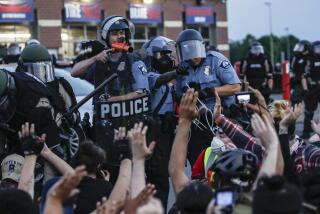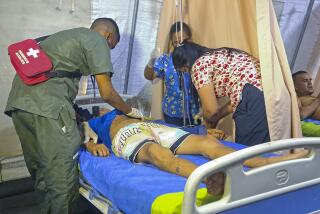South Africans decry police shootings at mine as ‘unacceptable’
JOHANNESBURG — It was the bloodiest crowd control incident in South Africa since the apartheid era, a time when security forces routinely suppressed black township protesters with bullets.
South Africans horrified by the police shooting deaths of 34 miners at the Lonmin platinum mine Thursday reacted with shock and anger, some saying the violence spotlighted government incompetence and others saying it was symptomatic of a disdain for the poor and least powerful.
The South African Institute of Race Relations, an independent think tank, compared the killings to the 1960 Sharpeville massacre when police killed more than 60 people. It called for the suspension of the police officers involved.
“What happened at Lonmin is completely unacceptable,” the institute said in a statement. “There is clear evidence that policemen randomly shot into the crowd with rifles and handguns. There is also evidence of their continuing to shoot after a number of bodies can be seen dropping and others turning to run.
“It would also appear as if they were not properly equipped to control a crowd.”
National Police Chief Mangwashi Phiyega defended her officers’ actions at a news conference Friday, saying they had no choice but to open fire when they were charged by a mob of angry miners, some armed with machetes, guns or sticks.
She said police tried tear gas, water cannons, stun grenades and rubber bullets, all of which failed to disperse the miners. In addition to the 34 deaths, 78 people were injured, she said.
Graphic video footage showed miners trying to rush at police, who responded by firing at them for about two minutes, as clouds of dust obscured the scene. When the dust cleared, numerous bodies were seen on the ground.
The majority of the police officers in the video were black; some in the front line were white.
While some South Africans defend the actions by police, others are saying that officers used excessive force.
They panicked, critics said, when charged by the miners, then opened fire and kept on shooting because they feared they would be killed. The shootings took place days after a mob of miners hacked two police officers to death and took their weapons.
Police arrested 256 miners after Thursday’s protest, the latest in what has become an increasingly common feature of South African life 18 years after the advent of democracy.
In a front page editorial headlined “African Lives as Cheap as Ever,” the Sowetan newspaper said the massacre called into question the quality of South Africa’s leaders.
“We wonder whether there isn’t a numbness that comes with the death of an African. It has happened in other parts of the world where wars reduced human beings to nothing more than physical particles. It has happened in this country before where the apartheid regime treated black people like objects. It is continuing in a different guise now,” the editorial said.
Protests are common in South Africa and often turn violent. Most are not about political freedom; they are more often a cry for a better life from poor, uneducated people living bleak, desperate lives with almost no hope of improvement.
South Africa’s townships and shantytowns see frequent protests over the government’s failure to deliver decent services, and a series of protests at mines have focused on better wages and work conditions.
Many of the striking miners are rock drillers, one of the dirtiest and most dangerous jobs underground.
Some commentators laid the blame on poor leadership, in barbed criticism of President Jacob Zuma, often seen as distracted by infighting and leadership squabbles in the ruling African National Congress.
Phiyega, the police chief, said officials first tried to persuade the strikers at the mine in Marikana, northwest of Johannesburg, to disperse, without success.
“The militant group stormed towards the police, firing shots and wielding dangerous weapons. Police retreated systematically and were forced to utilize maximum force to defend themselves,” Phiyega said.
An independent police body, the Independent Police Investigative Directorate, will look into whether the police action was justified, spokesman Moses Dlamini said Friday in a statement.
“The investigation will seek to establish if the police action was proportional to the threat that was posed by the miners. It is still early in the investigation to establish the real facts around this tragedy,” he said.
The violence broke out after police laid barbed wire to prevent miners from approaching the mine, Phiyega said. Miners then rushed forward, trying to outflank the police.
She said six guns were recovered from the bodies of the dead miners who had rushed at police, including two guns that belonged to the officers killed earlier in the week. Under South African law, police are entitled to use lethal force if they believe their lives are in danger.
Phiyega, who formerly led Transnet, the state freight agency, was appointed national police commissioner in June with no police experience.
The shootings Thursday brought the number of dead in the Lonmin platinum mine strike to 44. Miners walked off the job Aug. 10 demanding a 300% wage increase. The 10 killed before Thursday’s shootings included two police officers, two security guards and three officials of the National Union of Mineworkers, one of two unions struggling for dominance in South Africa’s platinum mines.
More to Read
Start your day right
Sign up for Essential California for news, features and recommendations from the L.A. Times and beyond in your inbox six days a week.
You may occasionally receive promotional content from the Los Angeles Times.






